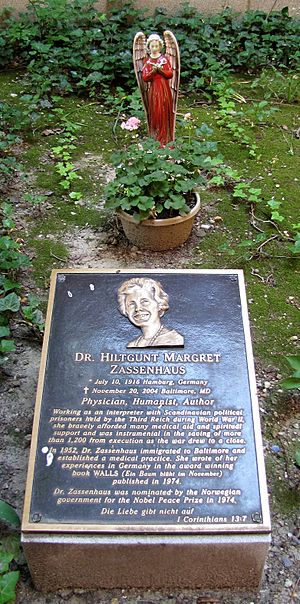Hiltgunt Zassenhaus facts for kids
Quick facts for kids
Hiltgunt Zassenhaus
|
|
|---|---|

Grave of Hiltgunt Zassenhaus (2009)
|
|
| Born | 10 July 1916 Hamburg, Germany
|
| Died | 20 November 2004 (aged 88) |
| Nationality | German |
| Occupation | philologist |
| Awards |
|
Hiltgunt Margret Zassenhaus (born July 10, 1916 – died November 20, 2004) was a brave German woman. She was a philologist, which means she studied languages and words. During World War II, she worked as an interpreter in Hamburg, Germany. Later, she became a doctor in the United States. She is remembered for helping prisoners during the war in Nazi Germany.
Contents
Growing Up and Education
Hiltgunt Zassenhaus was born in Hamburg, Germany. Her father, Julius H. Zassenhaus, was a historian and school principal. He lost his job in 1933 when the Nazi party came to power. Hiltgunt had three brothers. One of them, Hans, became a famous mathematician.
In 1933, Hiltgunt went on a bike trip to Denmark. This trip made her want to study languages. She decided to focus on Scandinavian languages like Norwegian and Danish. In 1939, she earned her degree from the University of Hamburg. She then continued her language studies in Copenhagen, Denmark.
Helping Prisoners During World War II
Working as an Interpreter
In 1940, Hiltgunt started working as an interpreter. She censored letters for the German government. But she didn't like this job. In 1942, she quit and began studying medicine.
Later that year, she was asked to censor letters again. This time, it was for Norwegian prisoners in a Hamburg prison called the Zuchthaus. She said yes, but only if she could work on her own. Instead of censoring, she secretly added messages to the letters. These messages told families to send food or warm clothes to the prisoners.
Smuggling Aid to Prisoners
Prisoners were allowed to have visitors. Norwegian priests in Hamburg were allowed to visit the prisoners. Hiltgunt was assigned to interpret for these priests. She also had to watch them during their visits. Later, she did the same for Danish priests and prisoners.
Hiltgunt used this chance to help. She began to secretly bring food, medicine, and writing supplies to the prisoners. The authorities suspected she might be part of the Gestapo (the secret police). This suspicion actually helped her. It made them less likely to check her actions closely.
Tracking and Saving Prisoners
As the war went on, prisoners were moved to many different prisons. Hiltgunt kept her own detailed records. She tracked where over 1,000 Scandinavian prisoners were held. They were scattered in 52 different prisons across Germany. These records became very important later.
Towards the end of the war, Hiltgunt learned about "Day X." This was a secret plan to kill all political prisoners. She shared her information and her prisoner files. She gave them to either the Red Cross or a Swedish count named Bernadotte. Because of her help, a deal was made. About 1,200 Scandinavian prisoners were set free. They were then transported safely out of Germany. This rescue mission was known as the White Buses operation.
Hiltgunt wrote about her experiences in a book. It was called Halt Wacht im Dunkel (1947). An English version, Walls, came out in 1974. In 1978, she was featured in a British TV show. It was called Women in Courage and showed women who stood up against the Nazis.
Life After the War
After World War II, Hiltgunt could not finish her studies in Hamburg. The city was badly damaged. Germans were not allowed to enter Denmark. So, in 1947, Hiltgunt was secretly brought into the country in a fish truck.
The Danish parliament then passed a special law. This law made her immigration legal. She continued her medical studies at the University of Bergen in Norway. She finally became a doctor at the University of Copenhagen. In 1952, she moved to Baltimore, USA. There, she worked as a practicing physician.
Hiltgunt Zassenhaus passed away on November 20, 2004. She was 88 years old.
Awards and Recognition
Hiltgunt Zassenhaus received many honors for her brave actions. She is the only German person to receive the Royal Norwegian Order of St. Olav. This award was given for her work during World War II.
She also received other important awards:
- The Red Cross Medal
- The Danish Order of the Dannebrog
- The German Bundesverdienstkreuz (Order of Merit)
- The British Cross of the Order of Merit
In 1974, the Norwegian government nominated her for the Nobel Peace Prize.
See also
 In Spanish: Hiltgunt Zassenhaus para niños
In Spanish: Hiltgunt Zassenhaus para niños

